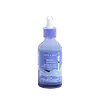What's inside
What's inside
 Key Ingredients
Key Ingredients

 Benefits
Benefits

 Concerns
Concerns

 Ingredients Side-by-side
Ingredients Side-by-side

Aloe Barbadensis Leaf Juice
Skin ConditioningFragaria Vesca Fruit Extract
AstringentVaccinium Angustifolium Fruit Extract
Skin ProtectingMorus Alba Fruit Extract
AntioxidantCucumis Sativus Fruit Extract
EmollientDaucus Carota Sativa Root Extract
Skin ConditioningPyrus Malus Flower Extract
Skin ConditioningCaprylic/Capric Triglyceride
MaskingCitrus Sinensis Peel Extract
PerfumingBorago Officinalis Seed Oil
EmollientPanthenol
Skin ConditioningGlycerin
HumectantGlycyrrhiza Glabra Root Extract
BleachingCaprylyl Glycol
EmollientArgania Spinosa Kernel Oil
EmollientSodium Ascorbyl Phosphate
AntioxidantAllantoin
Skin ConditioningChitosan
Sodium Hyaluronate
HumectantArbutin
AntioxidantHydrolyzed Dna
Skin ConditioningAdenosine
Skin ConditioningXanthan Gum
EmulsifyingHydroxyethylcellulose
Emulsion StabilisingCarbomer
Emulsion StabilisingDimethicone
EmollientCyclopentasiloxane
EmollientPhenoxyethanol
PreservativeSodium Benzoate
MaskingParfum
MaskingAloe Barbadensis Leaf Juice, Fragaria Vesca Fruit Extract, Vaccinium Angustifolium Fruit Extract, Morus Alba Fruit Extract, Cucumis Sativus Fruit Extract, Daucus Carota Sativa Root Extract, Pyrus Malus Flower Extract, Caprylic/Capric Triglyceride, Citrus Sinensis Peel Extract, Borago Officinalis Seed Oil, Panthenol, Glycerin, Glycyrrhiza Glabra Root Extract, Caprylyl Glycol, Argania Spinosa Kernel Oil, Sodium Ascorbyl Phosphate, Allantoin, Chitosan, Sodium Hyaluronate, Arbutin, Hydrolyzed Dna, Adenosine, Xanthan Gum, Hydroxyethylcellulose, Carbomer, Dimethicone, Cyclopentasiloxane, Phenoxyethanol, Sodium Benzoate, Parfum
Water
Skin ConditioningPropanediol
SolventVinyldimethicone
Glycerin
HumectantDipropylene Glycol
HumectantHydrogenated Lecithin
EmulsifyingGlycolipids
Skin ConditioningHydroxyacetophenone
AntioxidantBisabolol
MaskingCetyl Ethylhexanoate
EmollientMacadamia Ternifolia Seed Oil
EmollientSorbitan Stearate
EmulsifyingSodium Acrylate/Sodium Acryloyldimethyl Taurate Copolymer
Emulsion StabilisingPolyisobutene
Niacinamide
SmoothingPEG-5 Rapeseed Sterol
CleansingPolyglyceryl-10 Laurate
Skin Conditioning1,2-Hexanediol
Skin ConditioningCholesterol
EmollientPhytosteryl/Behenyl/Octyldodecyl Lauroyl Glutamate
Skin ConditioningDimethicone/Vinyl Dimethicone Crosspolymer
Skin ConditioningBakuchiol
AntimicrobialButyrospermum Parkii Butter
Skin ConditioningRetinol
Skin ConditioningTocopherol
AntioxidantDisodium EDTA
Ceramide NP
Skin ConditioningAcrylates/C10-30 Alkyl Acrylate Crosspolymer
Emulsion StabilisingDipotassium Glycyrrhizate
HumectantSucrose Cocoate
EmulsifyingSodium Hyaluronate
HumectantPentaerythrityl Tetra-Di-T-Butyl Hydroxyhydrocinnamate
AntioxidantRosa Damascena Flower Water
MaskingCaprylyl/Capryl Glucoside
CleansingAdenosine
Skin ConditioningSorbitan Oleate
EmulsifyingCetearyl Alcohol
EmollientStearic Acid
CleansingVanilla Planifolia Fruit Extract
Skin ConditioningPolyglutamic Acid
Skin ConditioningTromethamine
BufferingCamellia Sinensis Leaf Extract
AntimicrobialBenzotriazolyl Dodecyl P-Cresol
UV AbsorberGlyceryl Stearate
EmollientPolyglyceryl-10 Myristate
Skin ConditioningOleic Acid
EmollientButylene Glycol
HumectantSantalum Album Oil
MaskingCaprylyl Glycol
EmollientEthylhexylglycerin
Skin ConditioningCeramide Ns
Skin ConditioningPhytosphingosine
Skin ConditioningCarbomer
Emulsion StabilisingArginine
MaskingCeramide As
Skin ConditioningCeramide AP
Skin ConditioningCentella Asiatica Leaf Extract
Skin ConditioningCentella Asiatica Root Extract
Skin ConditioningCentella Asiatica Extract
CleansingSodium Dna
Skin ConditioningCeramide EOP
Skin ConditioningAcetyl Hexapeptide-8
HumectantPalmitoyl Pentapeptide-4
Skin ConditioningCopper Tripeptide-1
Skin ConditioningAsiatic Acid
Skin ConditioningAsiaticoside
AntioxidantMadecassic Acid
Skin ConditioningMadecassoside
AntioxidantWater, Propanediol, Vinyldimethicone, Glycerin, Dipropylene Glycol, Hydrogenated Lecithin, Glycolipids, Hydroxyacetophenone, Bisabolol, Cetyl Ethylhexanoate, Macadamia Ternifolia Seed Oil, Sorbitan Stearate, Sodium Acrylate/Sodium Acryloyldimethyl Taurate Copolymer, Polyisobutene, Niacinamide, PEG-5 Rapeseed Sterol, Polyglyceryl-10 Laurate, 1,2-Hexanediol, Cholesterol, Phytosteryl/Behenyl/Octyldodecyl Lauroyl Glutamate, Dimethicone/Vinyl Dimethicone Crosspolymer, Bakuchiol, Butyrospermum Parkii Butter, Retinol, Tocopherol, Disodium EDTA, Ceramide NP, Acrylates/C10-30 Alkyl Acrylate Crosspolymer, Dipotassium Glycyrrhizate, Sucrose Cocoate, Sodium Hyaluronate, Pentaerythrityl Tetra-Di-T-Butyl Hydroxyhydrocinnamate, Rosa Damascena Flower Water, Caprylyl/Capryl Glucoside, Adenosine, Sorbitan Oleate, Cetearyl Alcohol, Stearic Acid, Vanilla Planifolia Fruit Extract, Polyglutamic Acid, Tromethamine, Camellia Sinensis Leaf Extract, Benzotriazolyl Dodecyl P-Cresol, Glyceryl Stearate, Polyglyceryl-10 Myristate, Oleic Acid, Butylene Glycol, Santalum Album Oil, Caprylyl Glycol, Ethylhexylglycerin, Ceramide Ns, Phytosphingosine, Carbomer, Arginine, Ceramide As, Ceramide AP, Centella Asiatica Leaf Extract, Centella Asiatica Root Extract, Centella Asiatica Extract, Sodium Dna, Ceramide EOP, Acetyl Hexapeptide-8, Palmitoyl Pentapeptide-4, Copper Tripeptide-1, Asiatic Acid, Asiaticoside, Madecassic Acid, Madecassoside
Ingredients Explained
These ingredients are found in both products.
Ingredients higher up in an ingredient list are typically present in a larger amount.
Adenosine is in every living organism. It is one of four components in nucleic acids that helps store our DNA.
Adenosine has many benefits when used. These benefits include hydrating the skin, smoothing skin, and reducing wrinkles. Once applied, adenosine increases collagen production. It also helps with improving firmness and tissue repair.
Studies have found adenosine may also help with wound healing.
In skincare products, Adenosine is usually derived from yeast.
Learn more about AdenosineCaprylyl Glycol is a humectant and emollient, meaning it attracts and preserves moisture.
It is a common ingredient in many products, especially those designed to hydrate skin. The primary benefits are retaining moisture, skin softening, and promoting a healthy skin barrier.
Though Caprylyl Glycol is an alcohol derived from fatty acids, it is not the kind that can dry out skin.
This ingredient is also used as a preservative to extend the life of products. It has slight antimicrobial properties.
Learn more about Caprylyl GlycolCarbomer is a polymer of acrylic acid. Its main role is to create a gel consistency.
A high amount of carbomer can cause pilling or balling up of products. Don't worry, most products contain 1% or less of carbomer.
Glycerin is already naturally found in your skin. It helps moisturize and protect your skin.
A study from 2016 found glycerin to be more effective as a humectant than AHAs and hyaluronic acid.
As a humectant, it helps the skin stay hydrated by pulling moisture to your skin. The low molecular weight of glycerin allows it to pull moisture into the deeper layers of your skin.
Hydrated skin improves your skin barrier; Your skin barrier helps protect against irritants and bacteria.
Glycerin has also been found to have antimicrobial and antiviral properties. Due to these properties, glycerin is often used in wound and burn treatments.
In cosmetics, glycerin is usually derived from plants such as soybean or palm. However, it can also be sourced from animals, such as tallow or animal fat.
This ingredient is organic, colorless, odorless, and non-toxic.
Glycerin is the name for this ingredient in American English. British English uses Glycerol/Glycerine.
Learn more about GlycerinSodium Hyaluronate is hyaluronic acid's salt form. It is commonly derived from the sodium salt of hyaluronic acid.
Like hyaluronic acid, it is great at holding water and acts as a humectant. This makes it a great skin hydrating ingredient.
Sodium Hyaluronate is naturally occurring in our bodies and is mostly found in eye fluid and joints.
These are some other common types of Hyaluronic Acid:
Learn more about Sodium Hyaluronate